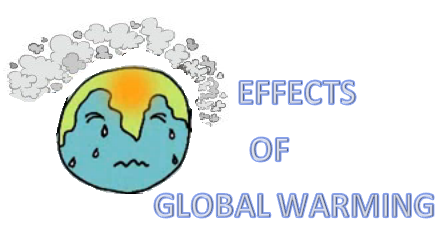Possible Effects of Global Warming
The predicted global warming in near future has the potential to affect the weather and climate, and level, and the distribution and phonology of organisms, food production and fishery resources in the ocean.

Effects on Weather and Climate
The global mean temperature has increased by approximately 0.60C in the 20the century. The average temperature of the earth may increase by 1.4 to 5.80C by the year 2100 from the 1990 level. Temperature changes are expected to be must marked in regions of middle and higher latitudes. Warming of atmosphere will considerably increase its moisture carrying capacity. While the troposphere warms up, the stratosphere will cool down. This would cause widespread changes in precipitation patterns due to changed pattern of air-mass movements. Precipitation is expected to increase at higher latitudes in both summer and winter and in southern and eastern Asia in summer. Winter precipitation may decrease at lower latitudes. Besides, the frequency of extreme events (e.g. droughts, floods, etc) is expected to increase substantially. The climate change will increase threats to human health, particularly in tropical and subtropical countries, due to change in ranges in disease vectors, water-borne pathogens, etc.
Sea Level Change
Sea level has been raised by 1 to2 mm per year during the 20th century. It is predicted that by the year 2100, the global mean sea level can increase up to 0.88m over the 1990 level. The global warming may contribute to sea level rise due to the thermal expansion of ocean as it warms, and melting of glacier and Greenland ice sheet. A rise of even half a meter in sea level would profoundly affect human population, one-third of which lives within 60km of a coastline. Many of the world's important cities and coastal areas will come under the threat of flood. Several low lying islands may be submerged. Inundation of coastal salt marshes and estuaries may deprive many important birds and fish their breeding grounds, forcing their extinction. Thus sea-level rise is projected to have negative impacts on human settlements, tourism, freshwater supplies, fisheries, exposed infrastructure, agricultural lands, and wetlands.
Effects on Range of Species Distribution
Each plant or animal species occurs which a specific range of temperature. The global warming is likely to shift the temperature ranges and, therefore, would affect attitudinal and latitudinal distribution pattern of organisms, with increasing global warming many species are expected to shift slowly poi ward, or toward high elevations in mountain areas. For example, with a global temperature rise by 2 to 50C during the 21th century, the temperature region vegetation may extend 250-600 km pole ward. Since trees are sensitive to temperature stress, a rapid rise in temperature may cause large scale death of trees and their replacement by scrub vegetation. Many species may not be able to migrate fact enough to track temperature changes and may disappear.
Food Production
Increased temperature may cause eruption of plant diseases and pests, explosive growth of weeds and increased basal rate of respiration of plants. A combination of all these factors will decrease the crop production. Small temperature increase may slightly enhance crop productively in temperate regions, but larger temperature changes will reduce crop productivity there. In all tropical and sub-tropical regions, even a small temperature rise will have detrimental effect on crop productivity. Rice yield alone, in south East Asia, will reduce by 5 percent for each 10 C increase in temperature. Despite beneficial CO2 fertilization effect, the overall world crop productivity will, in all probabilities, decline considerably due to projected global warming. This will have alarming consequences on world food supply.
Ways to Stop Global Warming
Some of the strategies that could reduce the warming by global stabilizing atmospheric concentrations of greenhouse gases include:
(i) Reducing the greenhouse gas emissions by limiting the use of fossil fuels. And by developing alternative renewable sources of energy (e.g. wind energy, solar energy, etc).
(ii) Increasing the vegetation cover, particularly the forest, for photosynthetic utilization of CO2.
(iii) Minimizing the use of nitrogen fertilizers in agriculture for reducing N2O emissions.
(iv) Developing substitutes for chlorofluorocarbons.
Average Acceleration Calculator
Average acceleration is the object's change in speed for a specific given time period. ...
When an object falls into the ground due to planet's own gravitational force is known a...
In Mathematics, the permutation can be explained as the arrangement of objects in a particular order. It is an ordered...
A rectangle can be explained as a 4-sided quadrilateral which contains equal opposite sides. In a rectangle
A three sided polygon which has three vertices and three angles is called a triangle. Equilateral triangle...







